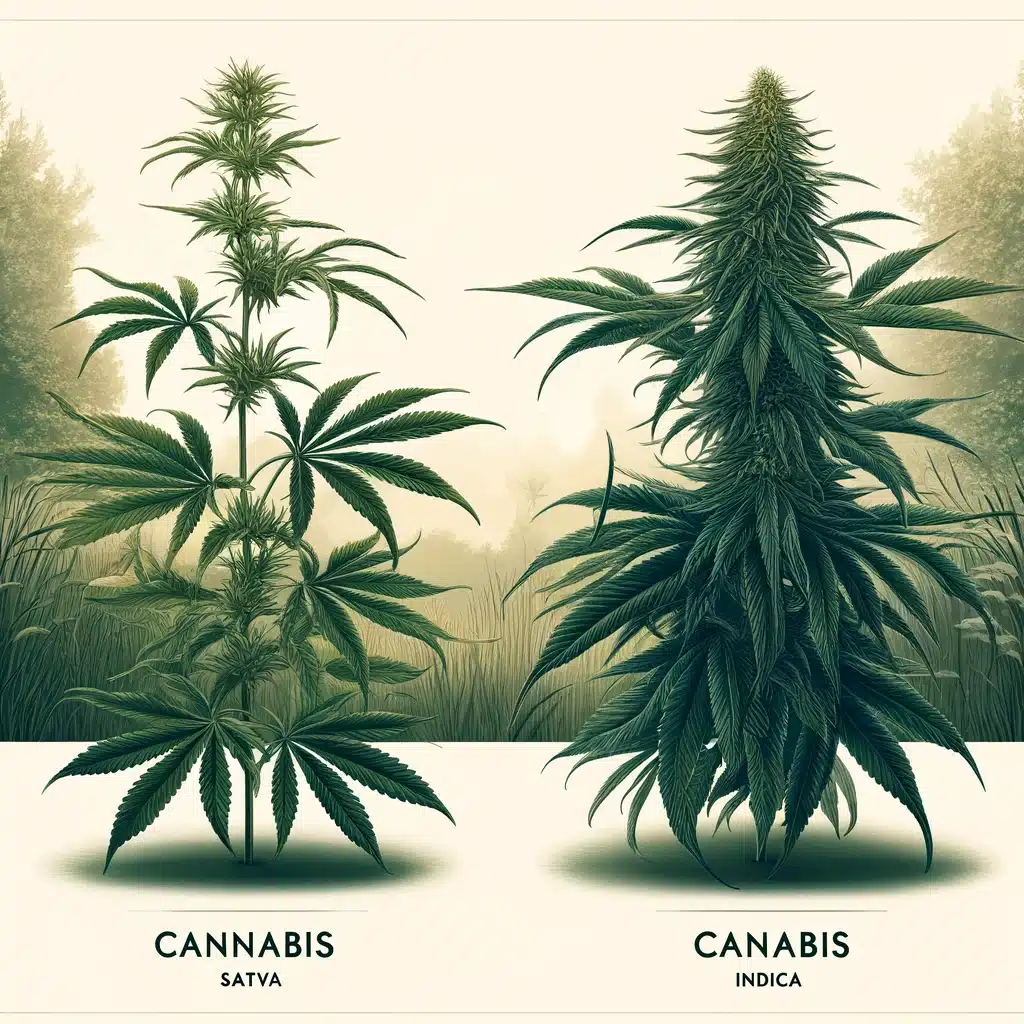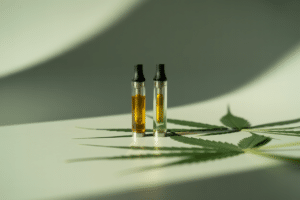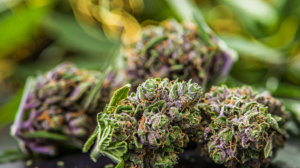- Classification is becoming outdated?
The Indica vs. Sativa Myth: How Expectancy Bias Shapes Your Cannabis High

Contents
Contents
Introduction Expectancy Bias
Cannabis, a plant steeped in history and controversy, is often categorized into two primary types: Indica and Sativa. These terms are deeply ingrained in cannabis culture, promising distinct effects like relaxation or energy. Yet, emerging scientific research is shaking the foundation of this traditional classification, revealing a far more nuanced landscape of cannabis strains and their effects.
As legalization expands and the cannabis industry grows, it’s imperative to understand the true nature of these strains. This article dives into the fascinating world of cannabis, dispelling the Indica vs. Sativa myth and exploring the complex interplay of chemical composition and expectancy bias on user experiences. Through the lens of scientific research and expert insights, we’ll uncover how our expectations shape our cannabis highs and how the future of strain classification is set to transform.
Cannabis Strains: An Overview
Cannabis strains are unique variations of the cannabis plant, each boasting distinct characteristics and effects. Traditionally, they’ve been classified into three main types: Indica, Sativa, and hybrids. These categories trace their roots back to geography, with Indica strains hailing from the mountainous Hindu Kush region and Sativa strains originating in warmer, equatorial areas.
Through a combination of natural selection and careful human intervention, a vast array of cannabis strains has emerged. Growers have selectively bred plants for centuries, enhancing desirable traits like increased yield, specific chemical compositions, and unique aromas. This has resulted in the diverse selection of strains available today, each with its own blend of cannabinoids (such as THC and CBD) and terpenes, the aromatic compounds that contribute to a strain’s distinct scent and potential therapeutic benefits.
Cannabis strains are a cornerstone of both recreational and medical cannabis use. Consumers often seek out specific strains based on their reputed effects, whether it’s relaxation, creativity enhancement, or pain management. However, it’s crucial to remember that the effects of any given strain can vary significantly from person to person, influenced by factors like individual biochemistry and how cannabis is consumed. Ongoing research is painting a more intricate picture of cannabis strains, challenging traditional classifications and revealing the plant’s true complexity.
Indica vs. Sativa: Debunking the Traditional Dichotomy
For decades, the Indica vs. Sativa dichotomy has been the cornerstone of cannabis culture, guiding consumers towards strains based on their desired effects. The common belief is that Indica strains offer sedating, body-focused highs, while Sativa strains deliver energizing, cerebral experiences. However, this simplistic classification is increasingly being challenged as an oversimplification of cannabis’s true complexity.
Traditionally, Indica strains are depicted as short, bushy plants with broad leaves, originating from the Hindu Kush mountains. They are often associated with relaxing, sedative effects, making them popular for evening use and potentially aiding in alleviating anxiety or insomnia. In contrast, Sativa strains are typically taller with narrow leaves, native to equatorial regions. These are often reputed to provide uplifting, cerebral effects, suitable for daytime use and potentially enhancing creativity or focus.
However, the reality of cannabis effects is far more nuanced than this binary system suggests. Extensive hybridization has blurred the lines between Indica and Sativa, resulting in countless hybrid strains that possess a mix of traits from both categories. Consequently, predicting a strain’s effects based solely on its classification is unreliable.
The true key to understanding a strain’s effects lies in its unique chemical composition, primarily its cannabinoids and terpenes. Cannabinoids like THC and CBD interact with the body’s endocannabinoid system, producing various effects, while terpenes contribute to the strain’s aroma and may also influence its therapeutic properties. For example, the terpene myrcene, found in both Indica and Sativa strains, is known for its sedative effects, challenging the notion that Indica strains are always calming.
The “entourage effect” further complicates the issue. This theory posits that the combined effects of cannabinoids and terpenes within a strain create unique experiences that cannot be attributed to any single compound or classification. Real-world examples abound: strains marketed as Indica sometimes produce energizing effects, while those labeled Sativa can be surprisingly calming.
As our knowledge of cannabis deepens, it’s becoming clear that the Indica vs. Sativa classification is a misleading oversimplification. A more nuanced approach, based on the strain’s specific chemical profile (chemotype) and individual responses, is necessary to guide consumers towards the most suitable cannabis experiences.

The Chemical Composition of Cannabis Strains: Unveiling the Plant’s True Power
The effects of cannabis are not solely dictated by whether a strain is Indica or Sativa, but rather by its unique chemical makeup. This composition, a complex interplay of cannabinoids, terpenes, and other phytochemicals, is the key to understanding a strain’s true potential.
Cannabinoids: The Building Blocks of Cannabis Effects
Cannabinoids are the most well-known compounds in cannabis, with THC (tetrahydrocannabinol) and CBD (cannabidiol) leading the charge. THC is the primary psychoactive ingredient, responsible for the characteristic “high” associated with cannabis use. In contrast, CBD is non-psychoactive and is celebrated for its potential therapeutic benefits, including reducing anxiety, inflammation, and pain.
Beyond THC and CBD, over 100 other cannabinoids exist in varying concentrations across different strains. These include lesser-known compounds like CBG (cannabigerol), CBN (cannabinol), and CBC (cannabichromene), each contributing to the plant’s overall effects. CBG, for instance, is being explored for its potential neuroprotective properties, while CBN is often associated with sedative qualities.
Terpenes: The Aromatic Powerhouses
Terpenes are the aromatic compounds responsible for the distinctive scents of different cannabis strains. However, their role goes beyond just aroma. Terpenes also significantly influence the effects of cannabinoids, interacting synergistically to create the “entourage effect.” This effect is a phenomenon where the combination of cannabinoids and terpenes produces unique effects that are greater than the sum of their parts.
Common terpenes found in cannabis include myrcene (sedative), limonene (uplifting), and pinene (alertness and memory). The specific blend of terpenes in a strain contributes to its overall effects profile, making it a crucial factor to consider when choosing cannabis products.
Beyond Indica and Sativa: The Importance of Chemical Profiling
The chemical composition of cannabis strains can vary widely, even among those classified as Indica or Sativa. This underscores the importance of moving beyond traditional classifications and focusing on the specific cannabinoid and terpene profiles of each strain. As research advances, the cannabis industry is embracing more detailed and accurate descriptions of products, empowering consumers to make informed decisions based on their individual needs and preferences.
Subjective Effects of Cannabis Strains: A Personalized Experience
The effects of cannabis strains are highly subjective, varying significantly from person to person due to individual biochemistry, tolerance, and the context of use. While the Indica vs. Sativa classification suggests distinct effects, these categories do not guarantee a universal experience. The intricate interplay of cannabinoids, terpenes, and each individual’s endocannabinoid system creates a unique response to each strain.
Reports of strain effects often paint a diverse picture. One person might find a particular Indica strain deeply relaxing and sleep-inducing, while another experiences mild euphoria and mental clarity. Similarly, a Sativa strain could be invigorating and creativity-enhancing for one person, but anxiety-inducing and restless for another.
Several key factors influence these subjective effects:
- Set and Setting: The user’s mindset (set) and the surrounding environment (setting) play a crucial role. A positive mindset and comfortable setting can amplify pleasurable effects, while a stressful or unfamiliar environment can lead to negative experiences.
- Dosage: The amount of cannabis consumed is also significant. Small doses might be stimulating, while larger doses can be sedative, regardless of the strain.
- Individual Differences: Physiological variations, such as genetic differences in the endocannabinoid system, contribute to the diversity of responses. Factors like metabolism, age, and overall health also influence how cannabis affects each person. Past experiences with cannabis can shape expectations and perceptions of its effects as well.
Understanding the subjective nature of cannabis experiences emphasizes the importance of personal experimentation and careful consideration when choosing a strain. It’s recommended to start with low doses and gradually increase, paying close attention to individual responses. This personalized approach empowers users to discover the strains that best suit their unique needs and preferences, rather than relying solely on the oversimplified Indica and Sativa labels.
The Power of Expectation: How Your Mind Influences Your Cannabis High
Ever felt like your cannabis experience was exactly as advertised, whether relaxed by a “Chill Kush” or energized by a “Super Silver Haze”? That might not be entirely coincidental. The potent force of expectancy bias, a psychological phenomenon where our beliefs influence our perceptions, plays a major role in how we experience cannabis.
Simply put, if you expect a certain type of high, you’re more likely to experience it, regardless of the strain’s actual chemical makeup. This is akin to the placebo effect, where the belief in a treatment’s efficacy can trigger real physiological and psychological responses.
Cannabis marketing and strain names often fuel this bias. They prime us with evocative descriptions and labels, solidifying the Indica/Sativa divide and creating expectations of specific effects. Imagine being handed a strain named “Couchlock” or “Dream Weaver” – you’re already setting the stage for a mellow experience, even before you take a puff.
Scientific studies have confirmed the power of expectancy bias in cannabis. In one study, users who believed they were consuming a high-THC strain reported stronger effects, even when the actual THC content was lower. Another experiment revealed that the same strain produced different reported effects depending on whether it was labeled Indica or Sativa.
The cannabis industry is no stranger to leveraging this phenomenon. Creative strain names like “Girl Scout Cookies” or “Gorilla Glue” evoke specific images and anticipated effects, subtly steering consumer expectations and choices.
Why Does This Matter?
Understanding expectancy bias is crucial for both recreational and medical users.
- Medical Users: It’s essential to approach cannabis treatment with an open mind and be guided by scientific evidence rather than preconceived notions.
- Recreational Users: Awareness of expectancy bias can prevent disappointment and promote a more informed, personalized cannabis experience.
Ultimately, by recognizing the influence of our expectations, we can cultivate a more nuanced and individualized understanding of cannabis. Let’s focus on the actual effects we experience and our unique responses, rather than simply relying on strain labels and marketing hype. This will empower us to navigate the diverse and ever-evolving world of cannabis with confidence and clarity.
Scientific Research on Cannabis Strains: Unveiling the Complexity Beyond Indica and Sativa
The scientific exploration of cannabis strain differences is still in its infancy, yet it has already shaken the foundations of traditional beliefs about the Indica vs. Sativa classification. Research increasingly shows that a strain’s chemical composition—the unique blend of cannabinoids and terpenes—is far more influential in determining its effects than whether it’s labeled as Indica or Sativa.
The Entourage Effect: A Symphony of Compounds
While THC and CBD are the most well-known players, research is revealing the significance of other cannabinoids like CBG, CBN, and the vast array of terpenes such as myrcene, limonene, and pinene. The entourage effect, where these compounds interact synergistically, is key to understanding a strain’s full spectrum of effects.
Challenges and Advancements
One major hurdle in studying strain differences is the lack of standardized research methodologies. Strains sharing the same name can have vastly different chemical profiles due to variations in cultivation practices, genetics, and environmental conditions. This inconsistency makes it difficult to draw definitive conclusions about the effects of specific strains.
However, advancements in cannabis genomics are revolutionizing the field. By mapping the genetic makeup of various strains, researchers are identifying markers that predict cannabinoid and terpene profiles, paving the way for more precise and consistent strain categorization. Additionally, controlled clinical studies are shedding light on how these compounds interact with the human body and influence therapeutic outcomes.
The Future of Strain Classification
The implications of this research are far-reaching. It suggests that a more sophisticated classification system based on chemical profiles, or chemotypes, is needed to replace the outdated Indica/Sativa labels. This shift could lead to more targeted and effective cannabis use, both medically and recreationally, unlocking the full potential of this multifaceted plant.
The Future of Cannabis Strain Classification: A Revolution in Personalization
Say goodbye to the outdated Indica vs. Sativa labels – the future of cannabis strain classification is about to get a whole lot more personalized and precise. Thanks to groundbreaking research in genomics and chemical analysis, a new era of strain categorization is dawning, one that focuses on chemotypes – the specific combinations of cannabinoids and terpenes that define a strain’s unique effects.
Chemotype-Based Classification: Your Personal Cannabis Guide
Imagine walking into a dispensary and seeing strains labeled not as Indica or Sativa, but by their unique chemical fingerprints. Instead of vague labels like “relaxing” or “energizing,” you’d see detailed descriptions of the strain’s dominant cannabinoids and terpenes, providing a more accurate prediction of the experience you can expect. This chemotype-based approach empowers consumers with the knowledge to choose the right strain for their specific needs and preferences.
Personalized Cannabis Experiences: The Next Frontier
As scientists continue to unravel the complex interactions between cannabinoids, terpenes, and our individual biochemistry, personalized cannabis experiences are becoming a reality. The future holds the promise of tailored cannabis products designed to address specific medical conditions, optimize therapeutic benefits, and cater to individual tastes and preferences. Whether you’re seeking relief from anxiety or looking to spark creativity, the right cannabis strain – identified by its chemotype – will be at your fingertips.
A Brighter Future for Cannabis Consumers
This revolution in strain classification is not just about fancy labels; it’s about empowering consumers to make informed choices and unlock the full potential of cannabis. For medical patients, it means access to more targeted and effective treatments. For recreational users, it opens the door to a wider range of personalized experiences. The future of cannabis is bright, and it’s all thanks to the power of science and a deeper understanding of this extraordinary plant.
Medical Cannabis Strains: Targeted Relief Beyond Indica and Sativa
Cannabis isn’t just for recreational use – it’s a powerful tool in the medical world, with different strains offering targeted therapeutic benefits. Choosing the right strain can be a game-changer for patients seeking relief from various conditions.
CBD-Rich Strains: Your Anti-Inflammatory and Anxiety-Reducing Allies
If you’re looking for relief from chronic pain or struggling with anxiety, CBD-rich strains could be your answer. These strains are packed with cannabidiol (CBD), a non-psychoactive compound celebrated for its potential to reduce inflammation and soothe anxious minds. They’re often used to manage conditions like arthritis, multiple sclerosis, and generalized anxiety disorder.
THC-Dominant Strains: Appetite Boosters and More
For those battling nausea, muscle spasms, or lack of appetite due to chemotherapy or conditions like multiple sclerosis, THC-dominant strains can offer much-needed relief. The psychoactive compound THC can stimulate appetite, ease muscle tension, and alleviate nausea, significantly improving quality of life for patients.
Hybrid Strains: The Best of Both Worlds
Hybrid strains, a mix of Indica and Sativa genetics, offer a balanced approach with a broader range of therapeutic benefits. They can provide pain relief while maintaining mental clarity, making them suitable for daytime use. These versatile strains are often used to manage conditions like chronic pain, migraines, and mood disorders.
Personalized Medicine: Finding Your Perfect Match
Remember, everyone’s body is different, and so is their response to cannabis. Medical professionals are increasingly recognizing the importance of tailoring cannabis recommendations to individual needs and preferences. Factors like dosage, consumption method, and medical history play a crucial role in determining the most effective strain and treatment plan for each patient.
The Future of Medical Cannabis: A Promising Landscape
The world of medical cannabis is rapidly evolving. While research is ongoing, the therapeutic potential of cannabis is undeniable. As scientists continue to uncover the intricacies of cannabinoids, terpenes, and their interactions with the human body, we can expect even more targeted and effective treatments in the future.
Choosing the Right Cannabis Strain: Your Personalized Guide to a Perfect High
Navigating the vast world of cannabis strains can feel overwhelming. But with a little knowledge and guidance, you can discover the perfect strain to match your unique needs and preferences. Follow these steps to unlock your ideal cannabis experience:
- Define Your Desired Effects:
Are you seeking relaxation, pain relief, a creativity boost, or something else? Pinpointing your desired effects is the first step towards choosing the right strain.
- Know Your Cannabinoids:
THC and CBD are the most prominent cannabinoids in cannabis, each offering distinct effects. THC is primarily responsible for the psychoactive “high,” while CBD boasts potential therapeutic benefits without intoxication. Consider whether you want a THC-dominant, CBD-dominant, or balanced strain based on your goals.
- Explore Terpene Profiles:
Terpenes are the aromatic compounds that give cannabis its unique smell and flavor, but they also play a role in its effects. Look for strains with terpenes known for the effects you desire: myrcene for relaxation, limonene for upliftment, pinene for focus, and so on.
- Start Low and Go Slow:
If you’re new to cannabis or trying a new strain, start with a low dose and gradually increase until you find your sweet spot. This will help you gauge your tolerance and avoid unwanted side effects.
- Research and Experiment:
Read online reviews, consult with knowledgeable budtenders, and don’t be afraid to experiment with different strains. Keep a journal of your experiences to track which strains work best for you.
- Consider Consumption Method:
The way you consume cannabis can influence its effects. Smoking, vaping, edibles, and topical applications each have their own unique onset times and durations. Choose the method that best suits your lifestyle and preferences.
Remember, finding the perfect strain is a personal journey. Your unique biochemistry and preferences play a major role in how you experience cannabis. Be open to exploring different options, listen to your body, and don’t be afraid to ask for guidance from experienced cannabis users or professionals. With a little patience and exploration, you’ll discover the strains that elevate your cannabis experience to new heights.
The Endocannabinoid System and CB1 Receptors: Your Body’s Cannabis Connection
The endocannabinoid system (ECS) is a complex network of receptors, enzymes, and endocannabinoids that exists throughout the human body. Think of it as your body’s own internal cannabis system. It plays a crucial role in maintaining balance, or homeostasis, by regulating various physiological processes, including mood, memory, pain sensation, appetite, and immune function.
At the heart of this system are the cannabinoid receptors, primarily CB1 and CB2. These receptors are like docking stations for endocannabinoids, neurotransmitters produced naturally by your body. When endocannabinoids bind to these receptors, they trigger a cascade of reactions that help regulate various bodily functions.
CB1 Receptors: The Key to Cannabis’s Psychoactive Effects
CB1 receptors are concentrated in the brain and central nervous system, playing a significant role in mood, cognition, and pain perception. This is why cannabis, which contains cannabinoids like THC, can have such profound effects on our mental and physical states.
When THC enters your body, it binds to CB1 receptors, mimicking the actions of your natural endocannabinoids. This can lead to the euphoric and psychoactive effects associated with cannabis, as well as potential therapeutic benefits like pain relief and appetite stimulation.
The Entourage Effect: Enhancing the Power of CB1 Receptors
Other cannabinoids, like CBD, and terpenes also interact with CB1 receptors, either directly or indirectly, influencing the overall effects of cannabis. This is where the entourage effect comes into play, as the various compounds in cannabis work together to create a unique experience. For example, CBD can modulate the effects of THC, potentially reducing anxiety and paranoia.
Unlocking the Potential of the ECS
Understanding the ECS and its intricate relationship with CB1 receptors is key to unlocking the therapeutic potential of cannabis. Ongoing research is revealing the complex ways in which cannabis interacts with the ECS, paving the way for new treatments for a wide range of conditions, from chronic pain to neurodegenerative diseases.
Absolutely! Here’s your optimized FAQ section, with a few extra questions added to provide more comprehensive information:
FAQs: Your Burning Questions About Cannabis Strains
- What’s the real difference between Indica and Sativa?
While Indica strains are traditionally associated with relaxation and Sativa strains with energy, these categories are becoming less reliable due to extensive hybridization. Modern cannabis strains often possess a mix of traits, making individual chemical profiles (cannabinoids and terpenes) the most accurate predictor of effects.
- Do different strains really have different effects?
Yes, different cannabis strains can produce distinct effects due to their unique combinations of cannabinoids and terpenes. However, individual responses can vary significantly based on personal biochemistry, dosage, and the environment (set and setting).
- How do I choose the right strain for me?
Consider your desired effects, research the strain’s cannabinoid and terpene profile, and start with a low dose to gauge your individual response. Don’t be afraid to experiment and consult with knowledgeable budtenders for personalized recommendations.
- Can expectancy bias affect my cannabis experience?
Absolutely. Your expectations can significantly influence how you perceive the effects of cannabis. Be aware of this bias and approach each experience with an open mind, focusing on your actual sensations rather than preconceived notions.
- What is the entourage effect?
The entourage effect refers to the synergistic interaction between cannabinoids and terpenes in cannabis. This means that the combined effects of these compounds can be greater than the sum of their parts, leading to a unique and potentially more beneficial experience.
- What are the most common terpenes in cannabis, and what are their effects?
Common terpenes include myrcene (relaxation), limonene (upliftment), pinene (focus), linalool (anxiety relief), and caryophyllene (potential pain relief). However, individual responses to terpenes can vary.
- How can I learn more about the chemical profile of a specific strain?
Many dispensaries and online resources provide detailed information on the cannabinoid and terpene profiles of different strains. Look for lab test results or certificates of analysis (COAs) for the most accurate information.
- Is it safe to mix different cannabis strains?
Yes, it’s generally safe to mix strains. In fact, some users find that combining strains with different cannabinoid and terpene profiles can lead to a more balanced and enjoyable experience.
- Are all cannabis strains safe for medical use?
While cannabis holds significant therapeutic potential, not all strains are suitable for everyone. It’s essential to consult with a healthcare professional to discuss your specific medical needs and determine the most appropriate strain and dosage for you.
- What does the future hold for cannabis strain classification?
The future of strain classification is moving towards a more personalized and precise approach, focusing on the specific chemical profiles (chemotypes) of individual strains rather than the outdated Indica and Sativa labels. This shift will empower consumers with more accurate information and lead to more targeted and effective cannabis use.
Don’t miss out on the latest cannabis insights and discoveries! Subscribe to our newsletter for exclusive content on strain effects, personalized cannabis experiences, and the ever-evolving science behind this fascinating plant. Stay informed and elevate your cannabis journey!
All information presented on this website, as well as any content provided through this platform, is intended solely for educational and informational purposes. This content is not a substitute for professional medical advice, diagnosis, or treatment, and should not be used as such. This website does not support, condone, or promote the use of illegal substances, nor does it encourage any illegal activity. Please consult with a qualified healthcare professional for any medical concerns or questions. For more information, refer to our full Disclaimer.




